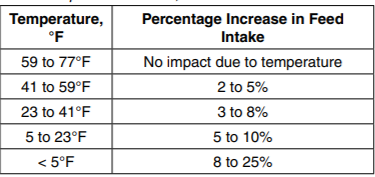Winter Cold Stress on Feedlot Cattle
Posted: January 6, 2022 | Written By: Heidi Doering-Resch, MS, Form-A-Feed

We often focus on what summer heat stress steals from our feedlot revenue; but we tend to put the blinders on when we try to account for what winter cold stress costs us as an industry. Perhaps living in the Midwest, we are accustomed to the cold stress and have the mentality to ‘just deal with it.’ I can say from personal experience; more performance projections are impacted from cold stress than heat stress. As managers, we have done an excellent job of trying to adapt to these cold stresses by building facilities that help to mitigate some of these stressors to a degree, however it’s not without some performance dips albeit our best efforts. Outlining some of the major concerns of cold stress and how to help mitigate them will help take the nip out of cold stress.
Energy requirements increase. This is the simplest one to see as cattle DMI increases during colder weather. The amount of DMI increase is dependent on cattle comfort and environmental conditions. See Photo 1.
Photo 1. Percent feed increase at temperatures below lower critical temperature (LCT)
Source: SD State Extension
- Holsteins vs. Native cattle
-
- Holsteins have a thinner hide, making cold stress even harder on them than Native cattle.
-
- When it gets below zero cattle intakes may drop as cattle are reluctant to come to the feed bunk.
Water issues. Water drives all intake. If cattle are not allowed to drink for any type of reason (water trough failure, stray voltage, frozen tanks, etc.) the animals will not eat, further causing performance issues. Remember that dry matter intake (DMI) drives average daily gain (ADG), so when we are already struggling for gain due to cold weather, water events exacerbate the issue that much more. Animals should urinate for about 8 to 10 seconds if well hydrated and you should have clear urine.
The three “W’s”, wet hides, wet pens, and wind. When you combine wet hides and wind you steal the most from your cattle. Wet hides take away insulation. If pens are wet during this period alongside the wind, your performance will drop. (See Photo 2 for ADG impact on Holstein Steers with a 10 mph wind).
Photo 2. Average Daily Gain of Holstein steers with a 10 mph wind

Source: IA State Extension
Thoroughly walk-through cattle to look for pop up health issues.
There are certain diseases that take these stressful times to show up and they may come on quickly. Weather fluctuations are more difficult on younger stock and already sick cattle. Make sure you take extra precaution with these type of cattle during extreme cold stress.
Feed Management
- Wet rations tend to freeze in the bunk, limiting the ability to consume during periods of extreme cold stress.
- Time of feeding may entice cattle to come to the bunk in extreme cold.
- If feeding 1 x a day, switching to 2x may entice cattle to come to the bunk.
- Feeding during the evening during extreme cold has been shown to improve ADG in cattle during winter months.
- Cattle give off heat of fermentation during the evening when temperatures are dropping.
- Keep feed fresh in the bunks. Don’t overfeed.
- Purging, fines or out of condition feeds can cause further metabolic issues.
- Don’t feed marginal or spoiled feeds during storms.
- This should be a ‘no brainer’ however dealing with spoiled feeds during times when the rumen bacteria may be depressed can cause further metabolic issues or death.
Pen management needs to be kept up
- Bedding cattle extra during cold temps helps reduce shivering and shows an improvement in performance (i.e., dry hide) regardless of being housed in inside or outside pens (See photo 3).
Photo 3. Impact of Modest and Generous Bedding in Feedlot Performance in Winter
Source: North Dakota State University
- Keeping bunk lines free of frozen manure and feed allows cattle to continue their normal feeding behavior.
- Provide a dry place for cattle to lie down.
- Cattle should drink, eat, and lie down. If you notice they are not laying down to ruminate their environment is not comfortable and your performance will suffer.

